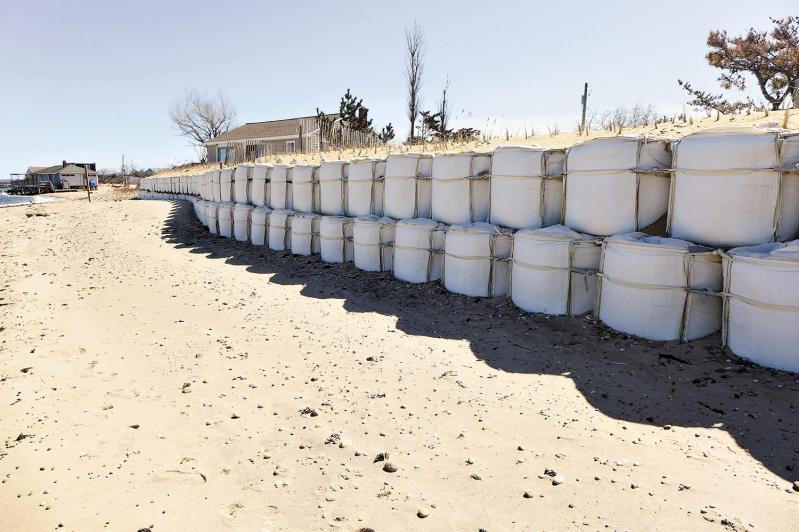In East Hampton Town, the massive geotextile sandbags that are used to protect waterfront properties from erosion are allowed on only a temporary basis — for just six months with the potential for a three-month renewal — but in reality those erosion-control measures have sometimes remained in place for years.
Now, the town board appears likely to amend the town code to allow more control over the installation and removal of new geotextile structures, based on recommendations from the Planning Department.
Geotextiles, commonly in the form of geocubes when stacked and tied together to protect waterfront properties, are the only temporary measures authorized in the code pertaining to emergency activities. Weighing around 1,700 pounds when filled with sand, their installation involves heavy machinery and excavation. Building permits are required, as is a removal and restoration plan.
But none of the seawalls comprising multiple geocubes installed in front of at least six properties in the town had executed removal plans at the end of their authorizations, Brian Frank, the Planning Department’s chief environmental analyst, told the board on Tuesday. Some have remained for years “with insufficient measures in place to compel their removal,” according to Mr. Frank’s presentation.
The emergency activity section of the code was adopted in 2007, part of broader legislation that was the final necessary requisite for the New York State Department of State to accept the town’s Local Waterfront Revitalization Plan, Mr. Frank said. “The duration of the permit really shouldn’t surprise any homeowner, contractor, or agent associated with the structure,” he said. “They really have every reason to expect, going in, the limitation and the temporary nature of this structure.”
The 2007 enabling legislation authorizing their use specified the time frame “because of the perception that a temporary structure of that nature is unlikely to result in a lot of the long-term impacts that are often associated with coastal erosion structures” such as revetments or groins. “It was really intended for an interim emergency measure to prevent the loss of, most often, a house, a principal structure, with the understanding that it has to be removed, restored, and more permanent solutions developed after that authorization is up.”
Adverse environmental impacts associated with erosion-control structures are visible at the installed geocube seawalls, Mr. Frank said, including “flank erosion” at the ends of the structures, a lowering of the beach from wave reflection, loss of public access along the foreshore, and “a general diminution of the coastal habitat” that town code regulations are intended to protect. “And aesthetically, it’s an exposed white plastic wall.”
“I think the impact of these structures over time is pretty undeniable, it’s demonstrable, it’s documented,” he told the board, “and it’s clearly contrary to the intent of protecting the shoreline with an erosion-control structure.” The code in its present form is inadequate to ensure geotextiles’ intended use, he said.
The suggested amendments would apply only to installation and removal of new geotextile structures. The building inspector would be empowered to consult with other town departments or officials to determine if a principal structure is in immediate risk of major structural damage, whereas the existing code limits that consultation essentially to the fire marshal or the town engineer. The building inspector would also be empowered to consult with an engineer other than the one who prepared the emergency activity plan.
A geotextile structure would be limited to the minimum length necessary to protect the principal structure on the property. “If we’re to protect somebody’s house in the short term,” Mr. Frank said, “then this structure should be used to protect the house, not necessarily span the entire width of the property.” The posting of a security equal to no less than twice the construction cost would be required, as would an access easement to permit entry to the property to remove the structure, should it remain after the expiration of its authorization.
The town’s beaches are its most precious resource, Supervisor Peter Van Scoyoc said. “This town attracts its whole economy based on the beaches, really, and the free public access to them. And we’ve seen the diminishment of public access because of these structures along shorelines that are impacted by erosion.” The town is facing “a situation of private property owners often spending huge amounts of money to be in close proximity to that beautiful resource.
. . . I think we need to do a better job as a community to protect that most precious resource. This is, I think, one step toward doing that. But the broader conversation is coming down to ensuring public rights of access, and protecting that resource over time. The public benefit has to outweigh the private interests if we’re going to retain our beach community.”
Board members were supportive of the proposed amendments, offering a few suggestions as to wording based on a draft they had reviewed. A revised draft will incorporate the board’s comments for review at an upcoming work session. The proposed amendments will then be scheduled for a public hearing.




